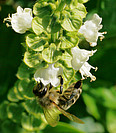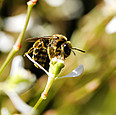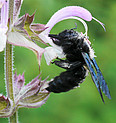Biodiversity-poem for children
Biodiversität im Gedicht für Kinder / Biodiversity-poem for children
Weißt Du wieviel Blümchen blühen
Auf dem weiten Erdenrund
Weißt Du wieviel Bienlein suchen
Nektar in dem Blütengrund
Gott der Herr, hat sie gezählet
Und das Eine sich nur wünschet
Dass der Mensch bewahrt sie alle
Dass der Mensch bewahrt sie alle
(Geeignet als dritte Strophe)
© H. Teppner, Oktober 2012
Gewidmet unseren Enkelkindern
P.S. Biologen nennen das Biodiversität und
helfen beim Zählen.
Do you know how many flowers
Bloom the whole world around
Do you know how many little bees
Search for nectar there to be found
God, our Lord, counts bees and flowers
And has given us the power
To protect and save them all
To protect and save them all
(Suited as third strophe)
© H. Teppner & S. Crockett, March 2014
Dedicated to the grandchildren
P.S. Biologists name this biodiversity and
help to count.
from the left:
Apis mellifera worker (Apidae) harvests pollen and nectar on Ocimum basilicum. The pollen load in the corbicula increases.
Andrena flavipes ♀ (Andrenidae) on Eryngium planum, sucking nectar. The yellow pollen is from another source. Pollen is transported not only on the hind legs but also in the corbiculae on the propodeum.
Lasioglossum calceatum ♀ (Halictidae) sucks nectar from one of the four nectaries on the cyathium of a Euphorbia leucocephala cultivar (= Euphorbia hypericifolia of European gardeners, non L.).
Xylocopa violacea ♀ (Anthophoridae) on Salvia sclarea. Nectar and pollen is collected. Often the mid-legs press the anthers to the body for a better pollen yield. In the case of a rich pollen offer it is transported in the scopae of the hind-legs (otherwise also in the foregut).
Herwig Teppner
Institut für BiologieInstitut für Biologie



